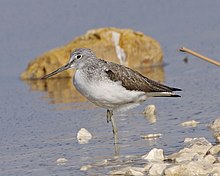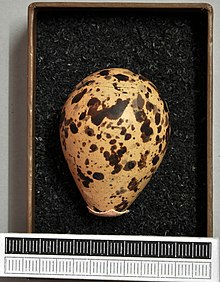Greenshank
| Greenshank | ||||||||
|---|---|---|---|---|---|---|---|---|

Greenshank ( Tringa nebularia ) |
||||||||
| Systematics | ||||||||
|
||||||||
| Scientific name | ||||||||
| Tringa nebularia | ||||||||
| ( Gunnerus , 1767) |
The greenshank ( Tringa nebularia ) is a monotypical species of bird from the family of the snipe birds (Scolopacidae). The greenshank is a breeding bird of the boreal zone of Northern Europe. In Central Europe he is a regular migrant during migration . Several thousand greenshanks can be observed in the Wadden Sea of the Netherlands in May and July to September.
description
A fully grown greenshank reaches a height of 33 centimeters and is therefore somewhat larger and, above all, longer-legged than the redshank . It has a wingspan of up to 70 cm and weighs up to 280 g. There is no sexual dimorphism .
The greenshank has long, gray-green legs and a long, strong, slightly upwardly curved bill. The top is patterned brown, gray and its belly is colored white.
The shy greenshank can swim and dive. In flight, like the redshank, it shows a wedge-shaped, white rump. Unlike the Redshank, however, it lacks the white drawing on the wings. It flies fast and powerful. Occasionally a restless zigzag flight can be observed. His call sounds something like "tjü tjü tjü".
Distribution area and habitat
The distribution area of the greenshank stretches from Scotland and Scandinavia to the tundra zones of Siberia and Kamchatka. The species is predominantly a long-distance migrant . Wintering quarters can be found in Atlantic Western Europe, in the Mediterranean region, from the Middle East to the African Cape Country, Sri Lanka, Rear India, on the Sunda Islands and in Australia. The main migratory route of the western Palearctic birds usually runs in a south-southwest direction. For example, Finnish breeding birds migrate to France, Italy and Poland. Inland Europe is widely flown over by greenshanks, but a concentration of trains can be observed along the coasts. Internationally significant rest areas and wintering quarters include the wetlands of the Finnish province of Oulau , the Wadden Sea of the North Sea, the Rhine-Maas Delta , the Banc d'Arguin on the Mauritanian coast and the mouth of the Niger River in Mali .
The migration from the breeding areas begins at the end of June. The first migrating birds can be seen on the Central European coasts from the end of June. The high point of the autumn migration is on the Schleswig-Holstein coast in July and on the Dutch coast in August. Withdrawal from the wintering quarters begins in March and in Central Europe the birds can be observed from the beginning of April. The greenshanks that breed in Fennoscandinavia arrive there in early to mid-May. There are also a number of summer birds in Africa.
The greenshank lives mainly on shallow waters such as moors , ponds and rivers . Outside the breeding season, it can be found in a variety of different wetlands, both on the coast and inland. He generally prefers open terrain on shallow water spots. It can be observed in tidal pools, in salt marshes, mangrove swamps and sewage fields as well as on floodplains.
nutrition
The greenshank feeds on worms , crustaceans , insects and their larvae . He also picks small fish from the shallow water with the right tool .
Characteristic of the greenshank is a very lively behavior while foraging for food. He often walks up and down and changes direction abruptly. The food is primarily located visually and then collected from the surface of the water, the soil or the vegetation. The greenshank pokes in the moist substrate much less frequently or searches for prey with sideways swiveling beak movements in the water. Occasionally, you can see tripping movements, which it probably uses to scare the prey from the bottom in the shallow water.
Reproduction
As a rule, the males reach the breeding areas before the females. They show a high degree of loyalty to the breeding site.
The breeding season extends from May to July. The nest is a flat hollow in the ground and is laid out with parts of plants . It is often located near a prominent rock, a tree stump or a piece of wood. The female lays four eggs , which are incubated by both parent birds for 24 to 25 days. The chicks flee the nest and are very active from the first day of life. They are led by both parent birds.
Duration
Current inventory
The breeding population in Europe is estimated at 75,000 to 160,000 breeding pairs at the beginning of the 21st century. The largest populations are in Finland (30,000 to 40,000 breeding pairs), Norway (15,000 to 30,000 breeding birds), Sweden (15,000 to 25,000 breeding pairs) and in the European part of Russia (14,000 to 65,000 breeding pairs). Around 1,000 breeding pairs also breed in Scotland and there are also very small populations in the Baltic States, Ukraine and Belarus.
Inventory forecast
The greenshank, like most of the snipe birds, is one of the species that will be particularly affected by climate change. A research team that, on behalf of the British Environmental Protection Agency and the Royal Society for the Protection of Birds, examined the future development of the distribution of European breeding birds on the basis of climate models assumes that the range of the greenshank will shrink considerably by the end of the 21st century will move north. Large parts of today's southern distribution area no longer offer suitable habitats for the species. According to these forecasts, the greenshank will cease to exist as a breeding bird in Scotland, southern Sweden, southern Finland and large parts of its present-day Russian range. Potential new distribution areas are parts of Iceland, Svalbard and Novaya Zemlya . However, these potential land gains cannot compensate for the land losses.
supporting documents
literature
- Hans-Günther Bauer, Einhard Bezzel and Wolfgang Fiedler (eds.): The compendium of birds in Central Europe: Everything about biology, endangerment and protection. Volume 1: Nonpasseriformes - non-sparrow birds. Aula-Verlag Wiebelsheim, Wiesbaden 2005, ISBN 3-89104-647-2 .
- Peter Colston , Philip Burton: Limicolen - All European wader species, identifiers, flight images, biology, distribution. BlV Verlagsgesellschaft, Munich 1989, ISBN 3-405-13647-4
- Simon Delany, Derek Scott, Tim Dodman, David Stroud (Eds.): An Atlas of Wader Populations in Africa and Western Eurasia. Wetlands International , Wageningen 2009, ISBN 978-90-5882-047-1 .
Web links
- Tringa nebularia in the endangered Red List species the IUCN 2008. Posted by: BirdLife International, 2004. Retrieved on January 3 of 2009.
- Videos, photos and sound recordings for Tringa nebularia in the Internet Bird Collection
- Age and gender characteristics (PDF; 1.2 MB) by J. Blasco-Zumeta and G.-M. Heinze (Eng.)
- Feathers of the Greenshank
Single receipts
- ↑ Bauer et al., P. 505
- ↑ Colston et al., P. 194
- ↑ Delany et al., P. 333
- ↑ Bauer et al., P. 506
- ↑ Colston et al., P. 195
- ↑ Delany et al., P. 330
- ↑ Bauer et al., P. 505 and p. 506
- ^ Brian Huntley, Rhys E. Green, Yvonne C. Collingham, Stephen G. Willis: A Climatic Atlas of European Breeding Birds , Durham University, The RSPB and Lynx Editions, Barcelona 2007, ISBN 978-84-96553-14-9 , P. 198





